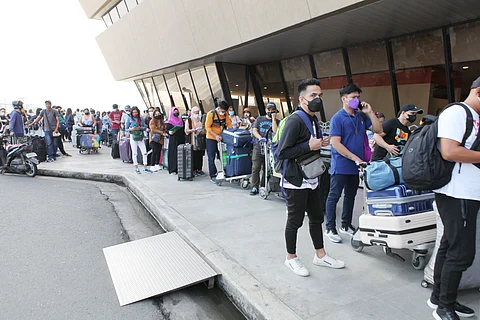
- NEWS
- the EDIT
- COMMENTARY
- BUSINESS
- LIFE
- SHOW
- ACTION
- GLOBAL GOALS
- SNAPS
- DYARYO TIRADA
- MORE

Millions of Filipinos leave home and opt to travel overseas to work every day, not for the luxury most seem to think of when traveling, but for survival and a hope for a better life for their families — they are the overseas Filipino workers (OFWs), often hailed as ‘modern-day heroes.’
Data from the Department of Migrant Workers shows that in January 2025 alone, a total of 331,291 land-based OFWs were deployed from regions across the country — a 39.24 percent increase compared to 237,930 deployments in January 2024. Of this total, 48,251 were new hires, while 283,040 were rehires.
Meanwhile, deployment of Filipino seafarers also saw a 74.14 percent increase in January 2025, from 51,972 deployed in January 2024 to 90,504.
Yet, more than just a symbol of a hero, their contributions through remittances keep the nation economically afloat.
Remittances and everything in between
Remittances are a quiet but powerful backbone of the economy.
In 2024, the Bangko Sentral ng Pilipinas reported that transfers from overseas Filipinos reached $38.3 billion, a three percent increase from the $37.21 billion recorded in 2023, indicating that despite global uncertainties ranging from inflation to geopolitical tensions, Filipinos continue to work, earn, and send money back home.
For households, this signals stability to fund essentials like food on the table, tuition fees, and utility bills, as well as small businesses. For the economy, it translates into stronger domestic consumption and a ‘buffer’ against external shocks.
A 2024 study by the BSP titled “Do Remittances Boost Household Spending? New Evidence from Migrants’ Household Survey” shows that Filipino households receiving remittances have better access to education, health, clothing, housing, and food than non-recipient households, indicating an upward mobility and improved quality of life.
It also showed that remittances are used more for immediate consumption than for saving and investing.
Working abroad, living apart
Yet, every benefit comes with a trade-off — something given up in return.
Behind the remittance figures are still honest people who spend years, sometimes decades, away from their families. They miss birthdays, graduations, and holidays to send money back home, a challenging opportunity that many feel they have no choice but to face.
OFWs are employed in a wide range of sectors. In a 2023 survey on OFWs by the Philippine Statistics Authority, most overseas workers were engaged in elementary occupations, which pertain to jobs involving the performance of routine tasks requiring the use of hand-held tools and physical effort, such as construction and domestic work. A significant number also work in shipping, healthcare, service, and sales, among others.
In addition to their contributions to the economy, they also serve as the nation’s most valuable assets. Their loyalty and dedication not only foster good relationships with other countries but are also evident in the strong relationships many have built with their employers, even in conflict-stricken parts of the Middle East.
Despite these, OFWs are no strangers to risks — stories that are the usual topic of DAILY TRIBUNE’s digital show Usapang OFW.
Over the past months, Usapang OFW has listened to and extended help to Filipino workers who have endured abuse, excessive working hours, denial of access to embassies, and untreated medical conditions.
OFWs face extreme risks
Among the most notable cases was that of Nahlah Bayan, a domestic worker in Riyadh who sought help over safety concerns when her male employer engaged in unnecessary physical contact, putting her at risk
There were also cases like Ramcitan Egalan’s, a worker overburdened with tasks for multiple members of the employer’s family, working at different houses, yet without a proper place to rest, and left to shoulder her medical expenses.
Perhaps the most harrowing story was that of Cristy Lavador, an OFW in Lebanon who endured the trauma of hearing bombs and warplanes. At the same time, her employer initially refused to let her return home. She was forced to keep working despite how the situation surrounding her took a toll on her health.
Authorities of the DMW have been responsive to cases facilitated by DAILY TRIBUNE, with most affected OFWs being able to return to the Philippines within two to three weeks. Yet, such incidents point to a troubling possibility — that there may be more OFWs suffering in silence, possibly overlooked due to the high volume of cases or a lack of proactive intervention.
The agency plays a crucial role in protecting workers and their rights. They have also visibly doubled their efforts to inspect recruitment agencies, pursue illegal recruiters, and shut down their operations. They run reintegration programs and make legal aid available, extending to parts of the country to support
The DMW has been playing a crucial role in protecting OFWs and promoting their rights. They have doubled their efforts to inspect recruitment agencies and go after illegal recruiters, shutting down their operations. However, for a workforce that sends home billions and keeps the economy steady, are these safeguards enough to match their sacrifices? Or is there still more the government can and should do for them?
According to the cases reported by DAILY TRIBUNE, there remains room to strengthen the systems meant to protect them. The long-term goal is not just to honor OFWs for their sacrifices, but to eventually build a future where working abroad is a choice, not a necessity.
